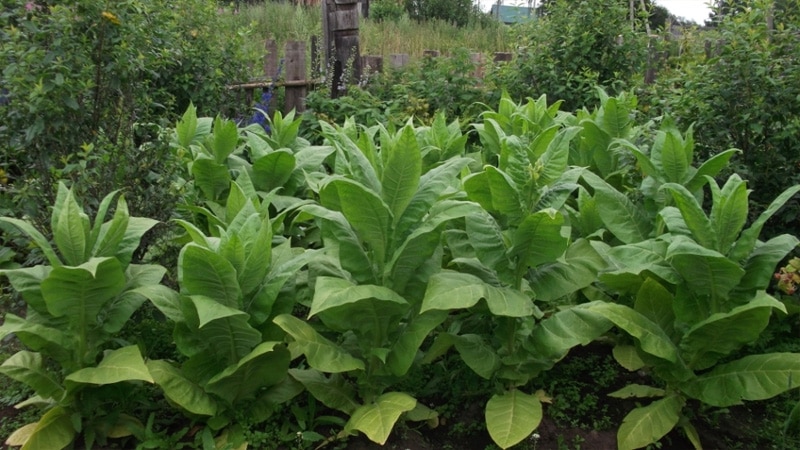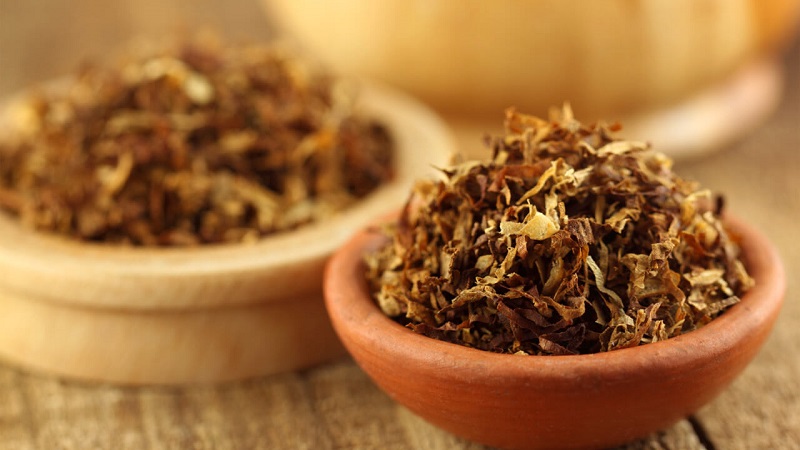When and how to collect tobacco and dry it properly at home
Your own garden and vegetable garden is an opportunity to eat your own vegetables and fruits all year round. The safety of the crop from parasites and pests is one of the main concerns of gardeners. The use of toxic insecticides jeopardizes the safety of the grown products, but there is another, safer solution.
Many plants accumulate organic protective substances - alkaloids. One of them - nicotine - is found in tobacco, which is widely grown by advanced gardeners.
The content of the article
The main stages of harvesting tobacco at home
Tobacco increased. What next to do with it before using it? The plant must be properly prepared and dried so that the resulting sushina contains sufficient nutrients and nicotine.
Procurement stages:
- Harvesting mature leaves.
- Languor and yellowing.
- Drying.
- Fermentation to increase the amount of nicotine.
- Final drying.
- Sorting sushina.
- Shredding.
- Storage.
Each stage of procurement has its own characteristics and secrets.

Collecting tobacco
Tobacco leaves on the bush ripen in tiers from bottom to top... The first lower tier can be plucked 40-45 days after planting, when flower buds appear. After the same period, the next tier is torn off and so on.
On one bush there are 4-8 tiers, which are harvested in turn. It is worth picking only those leaves that are at the stage of technical maturity, then they gain a sufficient amount of nicotine.
Maturity indicators of tobacco leaves:
- the density of the sheet plate increases, its surface becomes sticky;
- the color of ripe leaves changes to light yellow and yellow-green;
- light spots appear on the petiole - this is how accumulations of starch look;
- the edge of the leaf blade becomes wavy and falls to the ground, but the lower leaves may not have spots and waviness;
- petiole is easily separated from the stem;
- at night, mature leaves do not rise to the stem, but remain in a horizontal position.
For garden use, it is allowed to collect a small amount of overripe raw materials, although its effectiveness after drying decreases due to an insufficient amount of nicotine. Overripe leaves are less dense, yellow, and may have brown spots on the surface.
To shorten the drying time, the leaves are harvested in the evening in dry weather, until the evening dew has fallen.
Pressing lightly on the petiole, separate the leaf blade from the shoot. It should break off with a characteristic click. If, when pressed, the leaf does not break off, but bends down, this is an indicator of the immaturity of the raw material.
Parts of the plant damaged by phytoparasites are separated at any stage of maturity, they can be used for compost or burn without drying and crushing when fumigating fruit trees.
To obtain tobacco powder, you can cut off the entire tobacco shoots when the bulk of the leaves are ripe. Tobacco stalks contain less nicotine, but more mineral nutrients, and are more beneficial to use as fertilizers.
The languor and the burning of tobacco
When languishing, the leaves turn yellow, but remain alive, that is, chlorophyll disappears from the leaf plate. Simmering is called primary fermentation. The essence of languishing is keeping the raw material at high humidity and medium temperature.Evaporation temperature 25-35 ° С, humidity - 80-90%.
The collected leaves are washed from dirt and dried, then put in cardboard boxes and covered with a damp cloth. The boxes can be placed in the basement or greenhouse. 2-3 times a day, the leaves are shifted so that they do not rot and mold.
For light varieties of tobacco languor lasts 3-4 days, for dark green varieties - about a week. When languishing in the basement, due to a drop in temperature, the period may increase.
When the leaves are tired, turn yellow and lethargic, you can start the drying process.
Drying tobacco
How to dry tobacco? Drying at home does not require much time and resources.
Air drying
You can dry it hanging in the sun, in an apartment - on a windowsill or on a radiator. The yellowed torn leaves are strung on a strong rope so that they do not touch each other, and hung under a canopy or in the attic. In sunny weather, the threads are outweighed to an open place. At night, the leaves are covered with gauze to collect dew to reduce drying time.
In an apartment, leaves can be laid out in 1 layer on a windowsill or a battery. The leaves are periodically turned over to dry evenly.
Natural drying time is 12-30 days, depending on temperature and humidity.

Drying in dryer
With artificial drying, the complete yellowing of the leaf is not expected; it can be dried when the leaf has acquired a yellow color by one third. The leaves are laid out on the grates of an electric dryer or a tobacco dryer in 1 layer.
When using a special drying device, a minimum of costs will be required, since it contains programs for natural regulation of the temperature regime. The optimal temperature regime for tobacco is a gradual increase in temperature from 33 to 70 ° C within 5-7 days. Having loaded tobacco into a special dryer, you set the desired mode and leave it until the result is obtained.
To dry tobacco in an electric dryer, you need a device with a temperature regulator for the blown air. For 5 days every day the temperature on the regulator is increased by 10 ° C in order to maintain the temperature regime.
Drying in the oven
This process is similar to the fire-drying process carried out in the tobacco industry, with its help dark and strong varieties of tobacco.
The baking sheet is covered with parchment paper and the tobacco leaves are lined in 1 layer. No oven preheating is required before drying. Dried at a minimum temperature (80-90 ° C) with the door open.
To prevent the leaves from burning, they are placed on the upper level of the oven. Depending on the design of the oven, the drying time will be different, usually it takes 8-10 hours for soft tobacco or 15-20 hours for strong tobacco.
Determining the readiness of sushina
Dried tobacco leaves are light brown or dark brown and crumble when rubbed in the fingers. The vein of such leaves is fragile, breaks, and does not bend if you try to bend it. The best indicator of readiness is a fragrant tobacco smell. If the leaves are dry, they have black spots, or are completely black, the smell becomes unpleasant, pungent and burning.
Fermentation of tobacco
This process increases the free nicotine content. In the plant cell, nicotine accumulates in the vacuoles. For it to come out, the cell must be destroyed or nicotine must be washed out of the vacuoles without destroying the cells with an alcohol or vinegar solution.
For fermentation, the leaves are crushed, put in a glass jar and poured with a small amount of alcohol or vinegar (about 1-1.5 tbsp. L for 10-15 g of raw materials). Then the jar is sealed, shaken so that all the leaves are evenly wet, and left in a dark place for a week.
After 7-10 days, the tobacco leaves are removed from the jar and air-dried.
Note... The described fermentation method is suitable for tobacco used as an insecticide in horticulture.When using tobacco for smoking, vinegar is not used during fermentation, and instead of vodka, brandy, whiskey, alcoholic herbal tinctures and other aromatic alcoholic beverages are used. Smoking is bad for your health!
The tobacco used as fertilizer is not fermented.
Sorting dry leaves
After drying and fermentation, the leaves are sorted by color. Burnt illiquid assets are thrown away. From slightly burnt leaves, the blackened part is separated. The darker leaves contain more nicotine, it can be used first, and the lighter leaves are determined for long-term storage.

Shredding tobacco
To obtain tobacco powder, dry leaves can be ground in a coffee grinder or by hand in a mortar... After the first grinding cycle, the powder is sieved through a fine sieve, the large parts remaining on the grate are re-ground.
To obtain fertilizer, the leaves can be crushed by hand, rubbing with fingers, then larger particles are obtained.
Attention! Use gloves and a respirator, tobacco particles can cause severe irritation and redness of the skin.
Storing tobacco
The tobacco is well stored, retaining its properties for up to 5 years. Store it in sealed plastic, glass and metal containers in a low to moderate humidity room. You can use plastic bags with a plastic seal.
During storage, the aroma of the tobacco may decrease, but its insecticidal and nutritional properties will remain. If the temperature changes during storage, the color of the leaves may change.
Spoiled tobacco takes on an unpleasant burnt or rotten smell and turns black. If moisture gets into the dry land, the tobacco can become moldy. Such tobacco is thrown away or buried in the soil, away from the beds and fruit trees.
Ways to use tobacco in gardening
Gardeners use tobacco as a component of fertilizers, since the leaves of this plant accumulate up to 5% nitrogen, 1-3% potassium and 2% phosphorus.
Usually, crushed tobacco leaves are mixed with mineral fertilizers and applied to the soil in the following quantities:
- when planting garden trees, 1-2 glasses of tobacco fertilizer are introduced into the holes;
- before sowing lawn grass, add 30-40 g of fertilizer per 1 m² to the soil;
- after harvesting, to restore the soil, the soil is mixed with a tobacco-mineral mixture at the rate of 100 g per 1 m²;
- for feeding indoor and potted flowers ½ tsp. fertilizers are mixed with 10 liters of planting soil.
In addition to nutrients, tobacco contains a poisonous substance - nicotine (up to 1%), which does not accumulate in growing plants and quickly decomposes to non-hazardous substances. therefore tobacco is an environmentally friendly insecticide.
Tobacco powder, infusion and decoction of tobacco leaves are used as a remedy for pests:
- Tobacco powder is mixed in equal parts with ash or lime and the plants are pollinated with a dry mixture at the rate of ¼ glass per 1 m².
- Half a glass of tobacco leaf powder is poured into 1 liter of water, boiled for 30 minutes and left in a dark place for a day. After filtering, add 2 liters of water, dissolve 10-15 g of soap in the resulting broth. Plants are sprayed with tobacco broth 2-3 times every 7-10 days, 15 days before harvesting, spraying is stopped.
- The infusion of tobacco leaves is prepared for 2-3 days. To obtain it, 1 liter of hot water is poured into ½ cup of tobacco powder and left in a dark place. Filter the finished infusion, add 1-2 liters of water, dissolve 10-15 g of soap. Spraying is carried out similarly to spraying with a decoction.
- To fight pests fruit trees are fumigated. Small firewood, shavings, tree bark are lit in a metal container. When the fire flares up, tobacco powder is poured on top. The trees are fumigated for 0.5-2 hours. Such treatment is carried out after the flowering period so as not to frighten off pollinating insects.
Conclusion
The recommendations described provide tips on how to collect tobacco and how to dry it at home.To shorten the preparation time of tobacco, it is optimal to dry it in a special dryer. All stages of tobacco harvesting take on average 15 to 45 days. The finished product is used as an environmentally friendly fertilizer and insecticide.